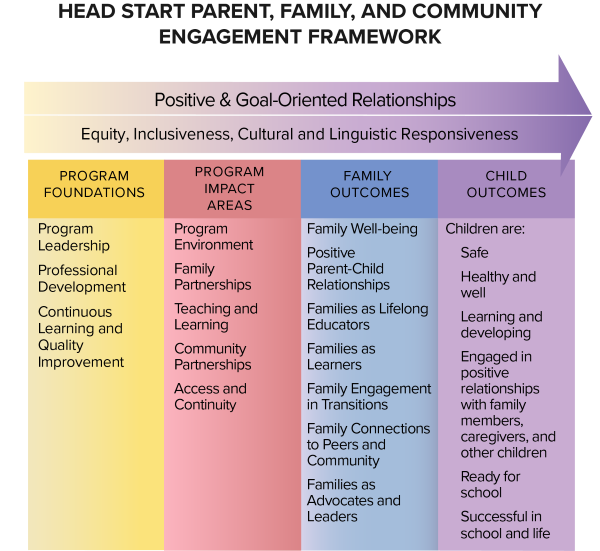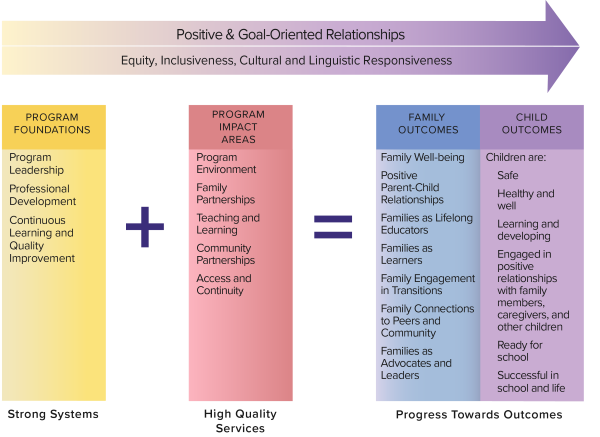 The Parent, Family, and Community Engagement (PFCE) Framework aligns your work with Head Start systems, services, and desired outcomes for children and families. It guides programs to develop partnerships with families and community organizations that result in improved outcomes for children, families, and communities. We achieve these partnerships and outcomes through positive, goal-oriented relationships grounded in equity, inclusiveness, and cultural and linguistic responsiveness.
The Parent, Family, and Community Engagement (PFCE) Framework aligns your work with Head Start systems, services, and desired outcomes for children and families. It guides programs to develop partnerships with families and community organizations that result in improved outcomes for children, families, and communities. We achieve these partnerships and outcomes through positive, goal-oriented relationships grounded in equity, inclusiveness, and cultural and linguistic responsiveness.
For PFCE practices to be effective and have a long-term impact on children and families, they need to be systemic, integrated, and comprehensive (SIC). These terms are defined as follows:
- Systemic. All Head Start and Early Head Start program staff have a role to play in promoting parent, family, and community engagement.
- Integrated. All parts of a program achieve better parent, family, and community engagement results by working together.
- Comprehensive. All programs design program services using a holistic approach that considers each child and family's strengths, interests, and needs.
To promote SIC family engagement, program staff must build strategies across Program Foundations and Program Impact Areas. In addition, when programs implement the elements in the Program Foundations through the lens of equity, program resources, systems, and policies support staff, families, and children to thrive.
If This, Then That
We can consider the PFCE Framework as a logic model for family engagement. If we build strong, family-centered systems (program foundations) and implement high-quality services (program impact areas), then we can better support successful outcomes for children and families.
Program Foundations: Creating Strong Systems
The Program Foundations include three elements that programs need to have in place and active to coordinate their systems: program leadership, professional development, and continuous learning and quality improvement.
Program leaders set clear goals, model effective PFCE practices, and ensure that program policies and procedures actively promote PFCE. Professional development supports all staff in learning and refining family engagement practices. Professional development also contributes to staff retention. Head Start program leaders, staff, and families engage in continuous learning. They use data from family and community strengths and needs assessments to learn about and improve the quality of their family engagement practices and support their program goals.
Program Impact Areas: Integrating High-quality Services
The Program Impact Areas highlight the five service areas with the greatest influence on family outcomes: program environment, family partnerships, teaching and learning, community partnerships, and access and continuity.
Program leadership and family services staff work together to develop a high-quality program environment that supports family and program staff interactions. These environments create opportunities to build partnerships between families and staff, families and other community organizations, and between and among families themselves. Family partnerships thrive when the relationships between program staff and families are ongoing, reciprocal, and respectful and when staff value families' unique expertise about their children.
Through teaching and learning in partnership, families and staff work together to promote children's learning, development, and school readiness. Families and staff share information about children and their progress. Community partnerships between Head Start programs, child care programs, and other community organizations support positive child and family outcomes by responding to families' interests and needs and connecting families to community resources. Access and continuity help to ensure that Head Start programs provide services to those families most in need through eligibility, recruitment, selection, enrollment, and attendance (ERSEA) procedures informed by community assessment data.
Family and Child Outcomes: Making Progress
The Family and Child Outcomes are all anchored in the Head Start Program Performance Standards. Together, program staff and families realize these outcomes every day. Programs partner with families to reach their goals and to support their engagement in children's learning and development for school success. These goals can be individual family goals set in Family Partnership Agreements, individual school readiness goals, or Individualized Family Service Plan or Individualized Education Program goals for children with identified delays or disabilities. Programs can explore strategies for implementing the PFCE Framework.
Positive and Goal-oriented Relationships
Building partnerships with families is grounded in positive, goal-oriented relationships to ensure the successful implementation of the PFCE Framework. These relationships develop over time through interactions between families and staff in Head Start and Early Head Start programs. In addition, they improve wellness by reducing isolation and stress for both families and staff. Staff and families form and strengthen these relationships with a focus on the goals they share for children. This approach allows families and staff to feel they are on the same team.
Relationship-Based Competencies
The relationship-building process requires knowledge, skills, and practices (KSPs). The Relationship-Based Competencies (RBCs) to Support Family Engagement outline the KSPs that all Head Start staff working directly with families must engage with to support parents and families successfully. The RBCs Guide for Early Childhood Professionals Who Work with Families includes:
- Examples of practices that build goal-directed partnerships with families
- Professional development assessments for:
- Family services professionals
- Supervisors of family services professionals
The assessments support professional growth and guide your team's professional development plans at the individual and program levels.
Explore the PFCE Simulation: Boosting School Readiness Through Effective Family Engagement Series to practice strategies you and your staff can implement in your daily work with families to develop positive and goal-oriented relationships. In addition, the Staff-Parent Relationships That Honor and Support Parenting will help you enhance your approach to fostering positive parent-child relationships.
Equity, Inclusiveness, and Cultural and Linguistic Responsiveness
 Understanding and respecting cultural beliefs and priorities are key underpinnings of the PFCE Framework. They are necessary for building relationships with families. In your program, you'll want to honor the cultural and linguistic diversity of the families you serve. In doing so, you'll be able to strengthen your partnerships by better understanding what is important to families and knowing how you and the program can best support them. Learn what it means to promote equity in Head Start programs.
Understanding and respecting cultural beliefs and priorities are key underpinnings of the PFCE Framework. They are necessary for building relationships with families. In your program, you'll want to honor the cultural and linguistic diversity of the families you serve. In doing so, you'll be able to strengthen your partnerships by better understanding what is important to families and knowing how you and the program can best support them. Learn what it means to promote equity in Head Start programs.
Throughout the tool, you will find examples and prompts to help integrate equity across the PFCE Framework.
Putting It into Practice Activity: Scenario and Reflections
Read the scenario, reflect on the related questions, and respond using the downloadable Positive, Goal-oriented Relationships and Equity Worksheet.
Scenario: Gloria and Her Family Services Team
Gloria's priority is to build a positive relationship with the family services team, families, fellow staff, and managers at her program. Now that she is aware of the program's vision and mission, PFCE Framework, and RBCs, she wants to understand the team's strengths and learn about the effective relationship-building practices the team has used to work with families and with each other.
Gloria and Molly meet with the family services team. Gloria asks the family services staff questions about their passions, culture, languages, and the current strengths of team members. James, a bilingual family services staff member, shares the partnerships he has built with the teaching staff to support families and children who are dual-language learners.
Gloria establishes an open-door policy with each family services staff member to support them as they work with children and families. She talks about setting up regular meetings as a group and individually. Gloria hopes that communicating regularly and being available to her staff will help build mutual trust and respect with the team.
Gloria and her team use reflection questions to reflect on positive, goal-oriented relationships and equity within their program. They decide to answer the questions individually and then discuss their responses together at their next team meeting.
Now it's your turn to reflect about positive, goal-oriented relationships and equity.
Reflection Questions About Positive, Goal-oriented Relationships and Equity
- What about building positive, goal-oriented relationships with families excites you?
- Think about a time when you had to build a relationship with a family or support a family services staff member in building a relationship with a family. What did you do well? What could you have done differently?
- How can you support your family services staff team in building relationships and partnerships with families?
- How do your program staff engage in equity efforts over time?
- Does your program have a definition of equity? How can you use your definition or the OHS definition in your program to orient new staff?
- How can you use your definition of equity in your program planning?
You Got This!
"You are never too old to set another goal or to dream a new dream."
-C.S. Lewis
Read more:
Resource Type: Article
National Centers: Parent, Family and Community Engagement
Audience: Family Service Workers
Last Updated: November 3, 2023